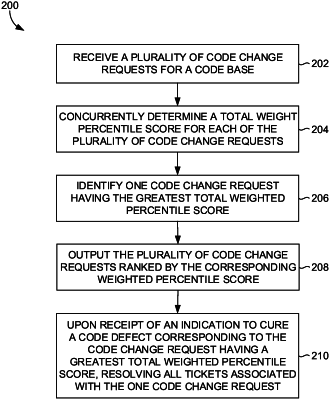| CPC G06F 8/70 (2013.01) [G06F 11/07 (2013.01); G06F 11/079 (2013.01); G06F 3/0482 (2013.01)] | 20 Claims |

|
1. A computer-implemented method, comprising:
receiving a plurality of code change requests associated with: a plurality of submissions and one or more code defects in one or more code bases;
concurrently determining a total weighted percentile score for each of the plurality of code change requests, wherein the total weighted percentile score is determined using a plurality of factors associated with a total submission count, a total client count, an obligation count, an average criticality, or a previously functional code base, and wherein the total weighted percentile score is an indicator of code defect impact;
identifying a first code change request having a greatest total weighted percentile score within the plurality of code change requests;
outputting the plurality of code change requests to a user device to display;
receiving an indication of a cure that has been implemented for a particular code defect that corresponds to the first code change request having the greatest total weighted percentile score within the plurality of code change requests;
inputting characteristics and prioritization factors of the plurality of code change requests to a machine learning model to identify a set of similar code change requests, from the plurality of code change requests, that correspond to the same particular code defect as the first code change request; and
responsive to determining that the particular code defect has been cured: automatically resolving, based on the cure, the set of similar code change requests in response to determining that the set of similar code change requests correspond to the same particular code defect.
|